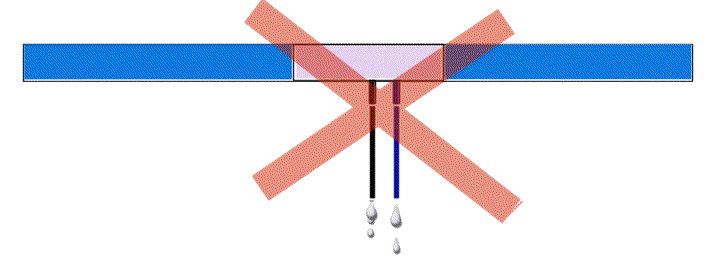Working with moist gases
Let's have a quick, comparative look on purely calorimetric volume flow measuring devices:
the mere presence of liquid droplets in the streaming air changes their "measured" results to a
random number, no kidding. But not so with the VSM-02! In principle, neither the measuring
precision nor the reliability are affected at all.
As in the case of compressed air, e.g., it is immediately clear that the air at the suction side,
which is taken from the environment, has a natural content of water vapour. This moisture condenses
during the generation of the compressed air and the resulting water must be
strictly kept away (with considerable effort) from the tubes and consumers. Mind you that corrosion
and damage would be just inevitable, if the water wasn't kept away from the compressed air. However,
the separation will not always reach 100 percent efficiency. So occasional droplets do occur. As
with most calorimetric measuring devices, the sensor areas are so small that a single droplet can
easily cover up most of the sensing area. The very high cooling effect of the liquid now mimics
an enormous (!) volume flow. If this occurs repeatedly, the overall value of the "measured" consumption
will be void. Not more and not less: just void. So, if somebody had to actually pay
for his measured consumption, why then any bothering with calorimetric measurings at all, if sometimes
a simple, archaic estimate would be a much better solution?
As said already, the VSM-02 uses a very different, more reliable physical method. The pressure
difference due to the Bernoulli effect occurs over the whole sectional area, thereby integrating
over the said area. It is therefore neither a spot measurement
that could be voided by any small local turbulence (which is, by the way,
just another nuisance of many competing calorimetric devices), nor is it
affected by the occasional water or oil droplet travelling by. The measuring method
does not depend on cooling properties, so one can forget about the related hassles. When working
with moist air or gas mixtures there are some easy guidelines
to keep in mind, though:
|
To the right: Wrong nozzle placement
|
 |
Mistake: Obeying the fundamental laws of gravity,
water and oil droplets tend to flow downwards, of course. It is obviously
no good idea to place the pressure hoses of the VSM-02 just in their way. The
liquids would fill the hoses after some time and might give the unsuspecting
operator even a sudden shower on opening the couplings.
|
To the right: Correct nozzle placement
|
 |
Right: Some droplets will always, by chance, find
their way into the lower sections of the pressure hoses. But this time, again
thanks to gravity, the droplets find their way out just on their own. No
external help needed. The streaming air finally carries the droplets away.
As a result, the pressure hoses of the VSM-02 stay permanently open and dry.
With a length of 2 m per hose and because of their flexibility, the hoses can also be led
from the nozzle to the measuring device in the shape of an arc. The only
important thing is to lead the hoses upwards away from the nozzle.
The same applies to vertically mounted tubes. The
hoses should form an arc leading to the VSM-02. In other words: the mounting
site of the device should be somewhere above the nozzle.
|







